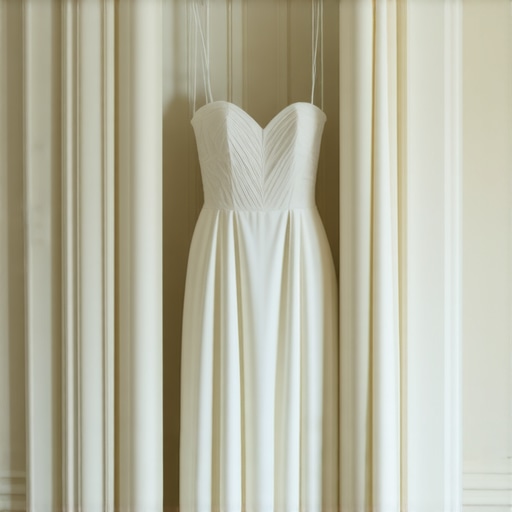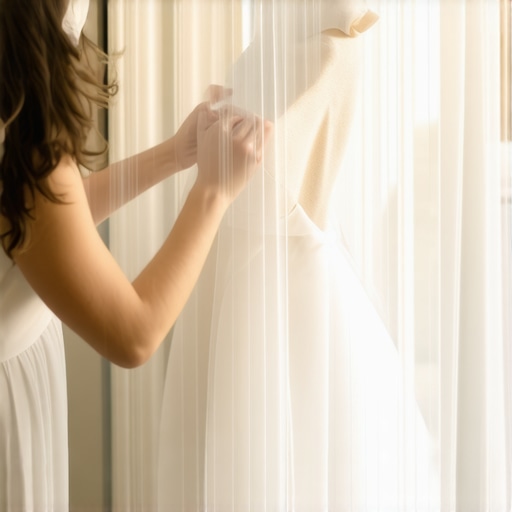My Personal Journey: Protecting My Wedding Dress in Tampa’s Climate
When I got engaged, I was overwhelmed with excitement and countless to-do lists. But one thing that stood out was how to keep my wedding gown pristine for years to come. Living in Tampa, I quickly learned that the humid subtropical climate can be a challenge for delicate fabrics, especially lace and vintage materials. I knew I had to take extra steps to protect my investment and preserve my bridal couture.
Discovering Tampa’s Best Wedding Dress Care Experts
After researching, I found that Tampa’s professional wedding dress cleaners are equipped with specialized techniques to handle sensitive fabrics. For example, professional cleaners in Tampa use eco-friendly and museum-quality preservation methods that ensure my gown stays flawless. Their expertise gave me confidence that my dress would be in safe hands.
How to Store Your Wedding Gown for Decades of Beauty
I invested in a high-quality preservation box, which is designed to keep out light, dust, and humidity—common enemies of preserved fabrics. I also learned that proper storage involves avoiding plastic bags, which can trap moisture and lead to mold or yellowing. Instead, breathable, acid-free tissue paper and preservation containers are the way to go. For my vintage gown, I relied on specialized vintage preservation techniques that protect delicate lace and embroidery.
Can Your Wedding Dress Survive Tampa’s Climate?
What are the key factors to consider for long-term preservation in Tampa’s humid weather?
Humidity control is vital. Tampa’s climate can cause fabrics to absorb moisture, leading to mold or mildew. I found that using silica gel packs and dehumidifiers in storage areas can significantly reduce this risk. Additionally, avoiding exposure to sunlight prevents fading and fabric deterioration. Regularly inspecting your gown, even after storage, helps catch any issues early. For thorough advice, I recommend reviewing dry cleaning tips for Tampa brides.
Sharing My Experience: Are You Ready to Protect Your Bridal Gown?
If you’re like me, you want to ensure your wedding dress remains as stunning as the day you wore it. I encourage every bride in Tampa to consult with local experts and invest in proper storage solutions. Have you already started your gown preservation journey? Feel free to share your tips or ask questions in the comments below. Remember, a well-preserved wedding dress is a cherished heirloom waiting to inspire future generations.
Understanding the Nuances of Tampa’s Climate for Wedding Dress Care
Tampa’s humid subtropical climate presents unique challenges for wedding dress preservation. Beyond basic storage, it’s essential to understand how humidity, temperature fluctuations, and light exposure can accelerate fabric deterioration. Humidity can cause mold growth and fabric yellowing, especially in vintage or delicate gowns. Temperature swings lead to fabric contraction and expansion, stressing seams and embroidery. Therefore, maintaining a consistent, cool, and dry environment is crucial for long-term preservation.
Innovative Preservation Techniques: Going Beyond the Basics
Modern preservation isn’t just about storing your gown; it involves using acid-free tissue, custom preservation boxes, and climate-controlled storage units. Some experts recommend vacuum-sealing gowns in specially designed breathable bags to minimize exposure to air and pollutants. For vintage gowns with fragile lace or embroidery, specialized cleaning and gentle restoration are vital before storage. Tampa’s top-tier preservation specialists employ techniques such as humidity-controlled environments and archival-quality storage solutions that meet museum standards, ensuring your gown’s longevity (learn more about museum-quality preservation).
How Can Brides Act Proactively to Protect Their Gowns?
Prevention starts with professional cleaning—preferably dry cleaning with eco-friendly, fabric-safe solvents—to remove stains, oils, and residues that could worsen over time. Regular inspections, ideally every few years, help identify early signs of damage or mold. When storing, avoid plastic bags, which trap moisture, and opt instead for acid-free tissue and breathable containers. Additionally, controlling the environment—using dehumidifiers and UV-filtering covers—significantly extends your gown’s lifespan. For detailed guidance, review eco-friendly wedding dress care tips and long-term storage strategies.
What Are the Practical Considerations When Choosing a Preservation Service?
Brides should look for experts with proven experience in handling sensitive, vintage, and high-end fabrics. Certifications from reputable associations and testimonials from local Tampa brides can provide valuable insights. An ideal service offers comprehensive solutions—cleaning, restoration, and storage—under one roof, with transparent pricing and a detailed preservation plan. Additionally, inquire about eco-friendly methods that align with sustainable practices, ensuring your gown remains beautiful without harmful chemicals. For trusted professionals, explore why professional cleaning matters.
Sharing Your Preservation Journey: Tips and Inspiration
Every bride’s gown is a unique story, and proper preservation helps keep that story alive. Consider documenting your gown’s condition with photographs and notes over time, especially if you notice changes. Sharing experiences and tips with fellow Tampa brides through local forums or social media groups can also be empowering. Remember, investing in professional preservation not only safeguards your dress but also transforms it into a cherished heirloom for generations to come. If you’re interested in exploring more expert advice, don’t hesitate to ask questions or share your own tips below—your story might inspire another bride to take action.
Unraveling the Nuances: How Tampa’s Climate Demands More Than Basic Care
Living in Tampa has taught me that preserving a wedding gown is a nuanced art, especially when facing the city’s humid subtropical climate. Beyond the obvious steps of dry cleaning and proper storage, understanding the subtle effects of temperature fluctuations, humidity spikes, and light exposure can make or break a gown’s longevity. For instance, I discovered that even minor temperature swings can cause fabrics to expand and contract, stressing seams and embroidery over time. This insight led me to invest in climate-controlled storage, which maintains a steady environment, safeguarding delicate fabrics from the wear and tear of Tampa’s unpredictable weather. It’s a reminder that long-term preservation requires a proactive, educated approach—one that considers the intricate dance between environment and fabric integrity.
Innovative Preservation Strategies: Going Beyond Traditional Methods
While traditional storage solutions like acid-free boxes and breathable garments are essential, I found that integrating technology elevates preservation efforts. For example, humidity sensors and UV filters can be installed in storage areas, allowing real-time monitoring and adjustments. Some Tampa experts employ vacuum-sealing gowns in specially designed breathable bags, reducing air and pollutant exposure without risking mold growth. For vintage or especially fragile gowns, gentle restoration techniques—such as hand-stitched reinforcement of lace or embroidery—are crucial before sealing them away. These innovations, rooted in museum-quality standards, ensure that your gown remains pristine for decades, even in Tampa’s challenging environment. The key is to collaborate with specialists who understand the complexities of fabric preservation in such climates, like those I trust in Tampa’s top-tier preservation facilities (learn more about museum-quality preservation).
What Are the Most Overlooked Factors That Accelerate Gown Deterioration?
One of the overlooked yet critical factors is the presence of airborne pollutants and dust, which can settle on fabrics, causing discoloration and weakening fibers over time. Tampa’s air quality, influenced by urban and coastal elements, can introduce these unseen enemies. Regularly inspecting storage areas and employing air purification systems can mitigate this risk. Additionally, the adhesives or dyes used in vintage gowns might degrade faster if exposed to fluctuating humidity and light, leading to discoloration or loss of structural integrity. This realization pushed me to prioritize not just the physical storage but also the micro-environment within. For brides seeking the ultimate preservation, consulting with experts who incorporate environmental controls—like those in Tampa’s specialized preservation centers—can make the difference between a gown that ages gracefully and one that deteriorates prematurely (more on museum-quality preservation).
Invitation for Brides: Share Your Preservation Experiences and Questions
As someone who’s navigated the complex journey of wedding gown preservation, I encourage brides to share their experiences, questions, and even concerns. Whether you’ve already taken steps or are just beginning, your story can inspire others to adopt more sophisticated, environmentally aware methods. Remember, the effort invested in understanding Tampa’s climate nuances and applying advanced preservation techniques not only protects your gown but transforms it into a cherished heirloom for generations. Don’t hesitate to comment below or reach out to Tampa’s professional experts—your gown’s future depends on it. Together, we can ensure that the beauty of our bridal couture endures amidst Tampa’s unique environmental challenges.
Deciphering the Impact of Tampa’s Microclimate on Vintage and Modern Bridal Gowns
Living amidst Tampa’s dynamic weather patterns has taught me that preserving a wedding dress involves more than just routine cleaning; it requires understanding the subtle influences of local microclimates. The city’s humidity, temperature fluctuations, and coastal pollutants can accelerate fabric degradation, especially for vintage lace or delicate silk fabrics. I discovered that employing climate-controlled storage units, equipped with dehumidifiers and UV filters, is essential for maintaining fabric integrity over decades. This proactive approach ensures that the gown’s color, texture, and embroidery remain vibrant, preserving its sentimental value and aesthetic appeal.
Innovative Preservation Solutions: Integrating Technology with Traditional Methods
Modern preservation techniques are revolutionizing how we protect bridal couture. For instance, incorporating humidity sensors and real-time environmental monitoring systems allows me to maintain optimal storage conditions. Vacuum-sealing gowns in specially designed, breathable, archival-quality bags has proven effective in minimizing air pollutants and preventing mold growth. Additionally, some experts recommend the use of microclimate enclosures with adjustable climate controls, akin to museum standards, which significantly extend a gown’s lifespan. These innovations exemplify the synergy of cutting-edge technology and traditional archival principles, ensuring your gown remains pristine for future generations (learn more about museum-quality preservation).

Addressing Overlooked Factors That Threaten Gown Longevity in Tampa
One often underestimated factor is the presence of airborne pollutants and dust particles that settle on fabrics over time. Tampa’s coastal air, influenced by urban emissions and salt spray, can introduce corrosive elements that weaken fibers and cause discoloration. Regularly inspecting storage environments and utilizing air purification systems are vital steps I recommend. Furthermore, the adhesives and dyes used in vintage gowns may degrade faster if exposed to fluctuating humidity or excessive light, risking structural and color integrity. These micro-environmental considerations underscore the importance of comprehensive preservation strategies tailored to Tampa’s unique environment.
Engaging with Experts: Elevating Your Preservation Practices
Collaborating with Tampa’s specialized preservation professionals has transformed my approach. Their expertise in customizing climate-controlled storage, gentle restoration, and eco-friendly cleaning solutions has been invaluable. For brides seeking to safeguard their investment, I advise seeking providers with credentials and proven experience in handling sensitive fabrics. Many of these experts employ museum-grade techniques, ensuring that your gown withstands the test of time without compromising its original beauty (discover more about museum-quality preservation). To deepen your understanding, I invite you to engage with seasoned professionals and share your preservation journey, fostering a community of informed bridal caretakers.
Things I Wish I Knew Earlier (or You Might Find Surprising)
Unseen Damage from Humidity
Living in Tampa, I underestimated how much humidity could affect my wedding gown. I thought dry cleaning was enough, but I later learned that humidity can lead to mold and fabric yellowing even years after the wedding. Investing in climate-controlled storage was a game-changer for me.
The Power of Proper Storage Materials
I used to store my gown in plastic bags, thinking they were protective. However, I discovered that acid-free, breathable containers are essential to prevent moisture buildup and fabric deterioration. This simple switch preserved my gown’s beauty much longer.
Importance of Regular Inspections
Initially, I didn’t think inspecting my gown every few years was necessary. But I realized early detection of mold or fabric stress can save a lot of trouble later. Regular check-ups help catch issues before they become irreversible.
Vintage Gowns Need Gentle Care
My vintage lace gown required specialized cleaning and minimal handling. I found that working with experts familiar with delicate fabrics ensures the gown’s longevity, especially in Tampa’s climate challenges.
Environmental Controls Make a Difference
Using silica gel packs and dehumidifiers in storage kept moisture at bay. I also learned that UV-filtering covers protect against light damage, which can fade fabrics over time. Small investments in environment control have enormous benefits.
Resources I’ve Come to Trust Over Time
- Museum of Fine Arts, Tampa: Their expertise in artifact preservation provided me with invaluable insights on climate-controlled storage and fabric care, making me more confident in my preservation methods.
- Wedding Dress Preservation Guide by the National Bridal Association: A comprehensive resource that explained the nuances of vintage gown care and the importance of professional cleaning—highly recommended for brides wanting to understand the science behind preservation.
- Eco-Friendly Cleaning Solutions by Tampa’s Local Experts: Their advice on sustainable and gentle cleaning techniques helped me choose eco-conscious options without sacrificing quality.
Parting Thoughts from My Perspective
Preserving a wedding gown, especially in Tampa’s challenging climate, is a nuanced process that goes beyond just dry cleaning. It’s about understanding the environment, choosing the right materials, and working with trusted experts. My experience has shown me that proactive care, regular inspections, and environmentally controlled storage are key to ensuring my gown remains a beautiful keepsake for decades. If you’re passionate about safeguarding your bridal heirloom, I encourage you to invest in professional advice and proper storage solutions. Remember, your gown is more than fabric; it’s a memory, a piece of your story, and worth every effort to preserve. If this resonated with you, I’d love to hear your thoughts or tips—feel free to share below.

